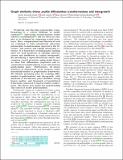Graph similarity drives zeolite diffusionless transformations and intergrowth
Author(s)
Schwalbe-Koda, Daniel; Jensen, Zach; Olivetti, Elsa A.; Gomez-Bombarelli, Rafael
DownloadAccepted version (3.151Mb)
Publisher Policy
Publisher Policy
Article is made available in accordance with the publisher's policy and may be subject to US copyright law. Please refer to the publisher's site for terms of use.
Terms of use
Metadata
Show full item recordAbstract
Predicting and directing polymorphic transformations is a critical challenge in zeolite synthesis1–3. Interzeolite transformations enable selective crystallization4–7, but are often too complex to be designed by comparing crystal structures. Here, computational and theoretical tools are combined to both exhaustively data mine polymorphic transformations reported in the literature and analyse and explain interzeolite relations. It was found that crystallographic building units are weak predictors of topology interconversion and insufficient to explain intergrowth. By introducing a supercell-invariant metric that compares crystal structures using graph theory, we show that diffusionless (topotactic and reconstructive) transformations occur only between graph-similar pairs. Furthermore, all the known instances of intergrowth occur between either structurally similar or graph similar frameworks. We identify promising pairs to realize diffusionless transformations and intergrowth, with hundreds of low-distance pairs identified among known zeolites, and thousands of hypothetical frameworks connected to known zeolite counterparts. The theory may enable the understanding and control of zeolite polymorphism. ©2019, The Author(s), under exclusive licence to Springer Nature Limited.
Date issued
2019-10Department
Massachusetts Institute of Technology. Department of Materials Science and EngineeringJournal
Nature Materials
Publisher
Springer Science and Business Media LLC
Citation
Schwalbe-Koda, Daniel et al., "Graph similarity drives zeolite diffusionless transformations and intergrowth" Nature Materials 18, 11 (November 2019): 1177–81 10.1038/s41563-019-0486-1 ©2019
Version: Author's final manuscript
ISSN
1476-4660